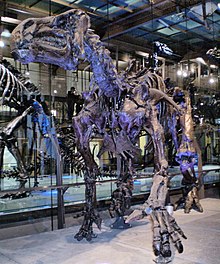
Back إغواندونيات Arabic الاغواندونيات ARZ Iguanodontidae Czech Iguanodontidae Spanish Iguanodontidae French איגואנודונטידים HE Iguanodontidae Italian イグアノドン科 Japanese იგუანოდონისებრნი Georgian 이구아노돈과 Korean
| Iguanodontids Temporal range: Early Cretaceous,
| |
|---|---|

| |
| Iguanodon bernissartensis mounted in modern quadrupedal posture, Royal Belgian Institute of Natural Sciences, Brussels | |
| Scientific classification | |
| Domain: | Eukaryota |
| Kingdom: | Animalia |
| Phylum: | Chordata |
| Clade: | Dinosauria |
| Clade: | †Ornithischia |
| Clade: | †Neornithischia |
| Clade: | †Ornithopoda |
| Clade: | †Hadrosauriformes |
| Family: | †Iguanodontidae Bonaparte, 1850 |
| Subgroups | |
| |
Iguanodontidae is a family of iguanodontians belonging to Styracosterna, a derived clade within Ankylopollexia.
Characterized by their elongated maxillae, they were herbivorous and typically large in size. This family exhibited locomotive dynamism; there exists evidence for both bipedalism and quadrupedalism within iguanodontid species, supporting the idea that individual organisms were capable of both locomoting exclusively with their hind limbs and locomoting quadrupedally.[2] Iguanodontids possess hoof-like second, third, and fourth digits, and in some cases, a specialized thumb spike and an opposable fifth digit.[3] Their skull construction allows for a strong chewing mechanism called a transverse power stroke.[4] This, paired with their bilateral dental occlusion, made them extremely effective as herbivores.[5] Members of Iguanodontidae are thought to have had a diet that consisted of both gymnosperms and angiosperms, the latter of which co-evolved with the iguanodontids in the Cretaceous period.[6]
There is no consensus on the phylogeny of the group. Iguanodontidae is most frequently characterized as paraphyletic with respect to Hadrosauridae,[7][8] although some researchers advocate for a monophyletic view of the family.[9][10]
- ^ Lockwood, Jeremy A. F.; Martill, David M.; Maidment, Susannah C. R. (2024-12-31). "Comptonatus chasei, a new iguanodontian dinosaur from the Lower Cretaceous Wessex Formation of the Isle of Wight, southern England". Journal of Systematic Palaeontology. 22 (1). doi:10.1080/14772019.2024.2346573. ISSN 1477-2019.
- ^ Galton, Peter (1976). "The Dinosaur Vectisaurus valdensis (Ornithischia: Iguanodontidae) from the Lower Cretaceous of England". Journal of Paleontology. 50 (5): 976–984.
- ^ Moratalla, J.J. (1992). "A Quadrupedal Ornithopod Trackway from the Lower Cretaceous of La Rioja (Spain): Inferences on Gait and Hand Structure". Journal of Vertebrate Paleontology. 12 (2): 150–157. doi:10.1080/02724634.1992.10011445. JSTOR 4523436.
- ^ Godefroit, Pascal (2012). Bernissart Dinosaurs and Early Cretaceous Terrestrial Ecosystems.
- ^ Weishampel, David (2012). Evolution of Jaw Mechanisms in Ornithopod Dinosaurs.
- ^ Barrett, P.M. (2001). "Did Dinosaurs invent flowers? Dinosaur-angiosperm coevolution revisited" (PDF). Biol. Revs. 76 (3): 411–447. doi:10.1017/s1464793101005735. PMID 11569792. S2CID 46135813.
- ^ Cite error: The named reference
iguanacolossuswas invoked but never defined (see the help page). - ^ Cite error: The named reference
AM12was invoked but never defined (see the help page). - ^ Cite error: The named reference
oldwas invoked but never defined (see the help page). - ^ Cite error: The named reference
monowas invoked but never defined (see the help page).
© MMXXIII Rich X Search. We shall prevail. All rights reserved. Rich X Search